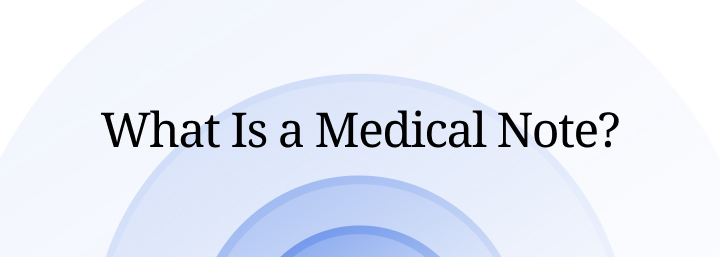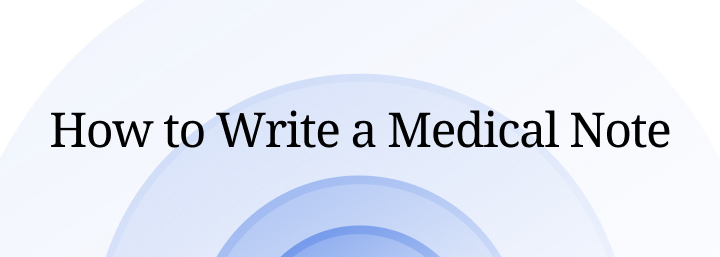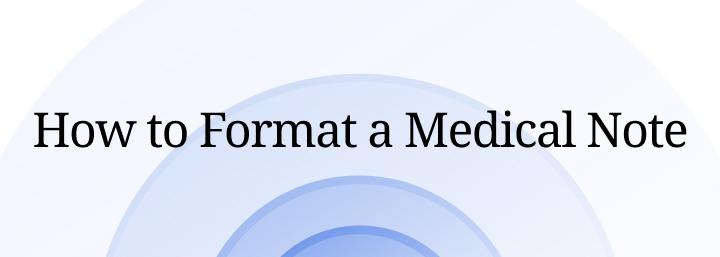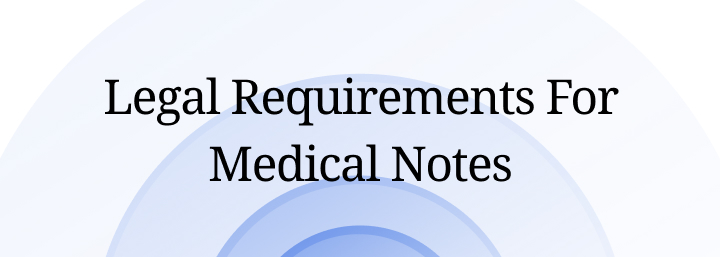Medical Note: A Complete Guide for Healthcare Professionals
Writing medical notes can also be time-consuming, tedious, and prone to errors. This blog post will cover everything you need to know about medical notes.
Table of Contents
What Is A Medical Note?
How To Write A Medical Note?
How To Format A Medical Note?
What Are The Common Abbreviations Used In Medical Notes?
Are There Any Legal Requirements For Medical Notes?
How To Ensure Patient Privacy In Medical Notes?
Can Patients Access Their Medical Notes?
Can Medical Notes Be Shared Between Healthcare Providers?
Conclusion
As a physician or clinic administrator, you know how important medical notes are for documenting patient care, communicating with other healthcare providers, and supporting clinical decision-making. However, writing medical notes can also be time-consuming, tedious, and prone to errors. This blog post will cover everything you need to know about medical notes. We will also introduce you to Tali, an AI medical dictation and ambient scribe that can help you create accurate and comprehensive medical notes in minutes.
What Is A Medical Note?

What Is a Medical Note?
A medical note is a written record of a patient’s health history, physical examination, diagnosis, treatment plan, progress, and outcomes. Medical notes are also known as clinical notes, progress notes, or chart notes. Medical notes serve several purposes, such as:
- Providing evidence of patient care and clinical reasoning
- Facilitating communication and coordination between healthcare providers
- Supporting billing and reimbursement processes
- Enhancing quality improvement and patient safety initiatives
- Contributing to research and education
Medical notes are part of the patient's medical record, a legal document containing all the information related to the patient's health and care. They can follow different formats, such as the SOAP note. The medical record may include other documents, such as laboratory reports, imaging studies, consent forms, prescriptions, referrals, and discharge summaries.
How To Write A Medical Note?

How To Write A Medical Note?
Writing a medical note can be challenging, especially when you must balance the competing demands of accuracy, completeness, brevity, and timeliness. Here are some general tips on how to write a good medical note:
- Write the note immediately after seeing the patient or performing the procedure. This will help you avoid forgetting important details or relying on memory alone.
- Use clear and concise language that is easy to understand by other healthcare providers. Avoid jargon, slang, abbreviations, or acronyms that may be unfamiliar or ambiguous to others.
- Be objective and factual. Do not include opinions, speculations, or personal comments irrelevant to the patient's care. If you have any doubts or uncertainties about the diagnosis or treatment plan, state them explicitly and explain your rationale.
- Be specific. Provide enough information to support your clinical judgment and decision-making. Include relevant data from history taking, physical examination, investigations, interventions, and outcomes. Quantify your findings whenever possible and use standard units of measurement.
- Be consistent and organized. Follow a logical structure and format that makes it easy to find and follow the information in the note. Use headings, subheadings, bullet points, tables, or charts to present information in a structured way.
- Be comprehensive but concise. Include all the essential information pertinent to the patient's care but avoid unnecessary or redundant information that does not add value or clarity to the note. Use short sentences and paragraphs that convey one idea at a time.
One of the most common formats for writing medical notes is the SOAP format, which stands for Subjective (what the patient says), Objective (what you observe or measure), Assessment (your diagnosis or impression), and Plan (your treatment or management). The SOAP format helps you organize your thoughts and systematically document your findings.
How To Format A Medical Note?

How To Format A Medical Note?
Formatting a medical note can vary depending on the type of note (e.g., admission note, progress note, discharge note), the specialty (e.g., internal medicine, surgery, psychiatry), the setting (e.g., hospital, clinic, home), and the preference of the healthcare provider or institution. However, some general principles apply to most medical notes:
- Use correct spelling and grammar. Use a spell checker or a proofreading tool to check your note for errors before finalizing it.
- Use punctuation marks (e.g., commas, periods, colons, semicolons) to separate sentences or clauses and improve readability.
- Use headings or subheadings to label each section of the note (e.g., History of Present Illness, Physical Examination, Diagnosis, Treatment Plan).
- Use indentation or alignment to create a visual hierarchy and separation between sections.
- Use bullet points or numbered lists to present multiple items or options concisely.
- Use tables or charts to display data or information in a structured way.
- Use bold or italic fonts to emphasize important points or keywords.
- If creating paper documentation:
- Use a standard font size (e.g., 12 point) and style (e.g., Times New Roman) that is easy to read.
- Use margins of at least 1 inch on all sides of the page.
- Use single or double spacing between lines depending on your preference.
What Are The Common Abbreviations Used In Medical Notes?
When writing or typing, medical notes often use abbreviations to save time and space. However, abbreviations can also cause confusion or misunderstanding if they are not standardized or recognized by other healthcare providers. Therefore, knowing the meaning and context of the abbreviations used in medical notes is important.
There are many types of abbreviations used in medical notes, such as:
- Abbreviations for medical terms, conditions, diseases, procedures, tests, or medications. For example, COPD stands for chronic obstructive pulmonary disease, ECG stands for electrocardiogram, and IV stands for intravenous.
- Abbreviations for units of measurement, symbols, or signs. For example, g stands for gram, + stands for positive, and < stands for less than.
- Abbreviations for directions, frequencies, or dosages. For example, a.c. stands for before meals, b.i.d. stands for twice daily, and i.m. stands for injection into a muscle.
- Abbreviations for names of healthcare providers, institutions, or departments. For example, Dr stands for a doctor, NHS stands for National Health Service, and ED stands for emergency department.
There is no universal or approved list of abbreviations used in medical notes. Different specialties, settings, or countries may have different abbreviations or conventions. However, some common sources provide guidance or recommendations on the use of abbreviations in medical notes, such as:
- The Joint Commission is an organization that accredits and certifies healthcare organizations and programs in the United States. It publishes a list of abbreviations that should not be used in medical notes because they are considered unsafe or error-prone.
- The World Health Organization is an agency of the United Nations responsible for international public health. It publishes a list of abbreviations commonly used in health information systems and documents.
- NHS Digital is an executive non-departmental public body of the Department of Health and Social Care in the United Kingdom. It publishes a list of abbreviations commonly used in the NHS App and other health records.
Are There Any Legal Requirements For Medical Notes?

Are There Any Legal Requirements For Medical Notes?
Medical notes are legal documents that can be used as evidence in court cases, audits, investigations, or complaints. Therefore, medical notes must comply with the legal requirements and standards of the jurisdiction where they are created and stored. Some of the common legal requirements for medical notes are:
- Accuracy: Medical notes must reflect the truth and reality of what happened during the patient encounter. They must not contain false, misleading, or inaccurate information that could harm the patient or the healthcare provider.
- Completeness: Medical notes must include all the relevant and necessary information related to the patient's care. They must not omit significant details or facts that could affect the patient's outcome or the healthcare provider's liability.
- Timeliness: Medical notes must be written immediately after seeing the patient or performing the procedure. They must not be delayed, backdated, or altered after the fact.
- Legibility: Medical notes must be written clearly and readable so that other healthcare providers can understand. They must not be illegible, incomprehensible, or ambiguous.
- Confidentiality: Medical notes must be kept in a secure and private place accessible only to authorized persons. They must not be disclosed, shared, or copied without the patient's consent or a valid legal reason.
How To Ensure Patient Privacy In Medical Notes?
Patient privacy is a fundamental right and a legal obligation for healthcare providers. Patient privacy means that patients have control over who can access their personal health information and how it can be used. Healthcare providers must respect and protect patient privacy by following the principles of confidentiality, consent, and security.
Confidentiality means that healthcare providers must not disclose or share patient information with anyone who is not involved in the patient’s care or who does not have a legitimate need to know. Healthcare providers must also ensure that patient information is not accidentally or intentionally leaked, lost, or stolen.
Consent means healthcare providers must obtain patient permission before collecting, using, or disclosing patient information. Consent can be expressed (e.g., written or verbal) or implied (e.g., inferred from the patient's actions or circumstances). Consent can also be withdrawn at any time by the patient.
Security means that healthcare providers must take reasonable steps to safeguard patient information from unauthorized access, use, modification, destruction, or disclosure. Security measures may include physical (e.g., locks, alarms), technical (e.g., passwords, encryption), and administrative (e.g., policies, procedures) controls.
Can Patients Access Their Medical Notes?
Patients can access their medical notes under certain conditions and limitations. Patients can request access to their medical notes from their healthcare provider or institution by following the established process and providing the required information. Patients may have to pay a fee to obtain copies of their medical notes.
Patients can access their medical notes for various reasons, such as:
- To review their health history and progress
- To verify the accuracy and completeness of their information
- To share their information with other healthcare providers
- To exercise their legal rights or pursue a claim
However, patients may not be able to access their medical notes in some situations, such as:
- When the access would pose a serious threat to the patient’s health or safety
- When the access would violate another person’s privacy or confidentiality
- When the access would interfere with an ongoing investigation or legal proceeding
- When access is prohibited by law or regulation
Can Medical Notes Be Shared Between Healthcare Providers?
Medical notes can be shared between healthcare providers involved in the patient's care or who have a legitimate need to know. Sharing medical notes can facilitate communication and coordination between healthcare providers and improve the quality and continuity of care for patients.
However, sharing medical notes also entails risks and responsibilities for healthcare providers. Healthcare providers must ensure they share medical notes only with authorized persons and for authorized purposes. Healthcare providers must also ensure that they share medical notes securely and appropriately, which respects patient privacy and confidentiality.
Some of the common methods of sharing medical notes between healthcare providers are:
- Paper-based: Healthcare providers can print out copies of medical notes and send them by mail, fax, courier, or hand delivery. This method is simple and familiar but also slow and unreliable.
- Electronic: Healthcare providers can use email, text, or instant messaging to send electronic copies of medical notes. This method is fast and convenient but also vulnerable to hacking, interception, or misuse.
- Online: Healthcare providers can use online platforms, such as portals, networks, or cloud services, to upload, store, and share medical notes. This method is efficient and accessible but also dependent on internet connectivity, compatibility, and security.
- Verbal: Healthcare providers can communicate medical notes verbally by phone, video call, or face-to-face conversation. This method is direct and personal but also prone to misunderstanding, distortion, or omission.
Conclusion
Medical notes are essential for providing quality patient care and ensuring legal compliance. However, writing medical notes can also be daunting and time-consuming for healthcare providers. We created Tali, an AI medical dictation and ambient scribe that can help you create accurate and comprehensive medical notes in minutes.
Tali is a smart and easy-to-use solution that captures the relevant information from your patient encounter and generates a structured and formatted medical note that follows the SOAP format. Tali saves you time and hassle by eliminating the need for typing, clicking, or scrolling.
With Tali, you can focus more on your patients and less on your paperwork. Tali helps you improve your productivity, efficiency, and satisfaction as a healthcare provider. Tali also helps you improve your patient outcomes, satisfaction, and loyalty by providing them with better care and communication.
If you want to experience the benefits of Tali for yourself, you can try it for free today.





